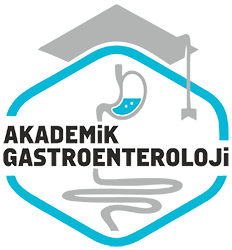Aralik 2018
Kolon polipleri ve diyet ilişkisi
Relationship between colon polyps and diet
- Ana Sayfa
- Sayılar
- Aralik 2018
- Kolon polipleri ve diyet ilişkisi...
Özet
Giriş ve Amaç:Diyet aliskanliklari ve spesifik besin gruplarinin kolon polip gelisimi, histolojisi ve boyutlari üzerindeki etkisinin aydinlatilmasi. Gereç ve Yöntem: 2012-2015 yıllari arasında kolonoskopi yapılan 1004 hasta beslenme aliskanliklari yönünden prospektif olarak değerlendirildi. Hastalar kolon polibi var-yok, kolon polibi olanlar ise hiperplastik-adenomatöz, <1 cm - >1 cm olarak siniflandirildi ve gruplar arasi diyet aliskanliklarinin farklari incelendi. Bulgular: Çalışmamızda kolon polip gelismesini; yaş, erkek cinsiyet, kirmizi et ve bulgur tüketimi arttirirken, domates tüketimi azaltmaktadır. Adenomatöz histoloji görülme sikligi- ni artiran faktörler yaş ve bulgur tüketimi olarak saptanırken; azaltan faktörler ise yumurta ve pirinç tüketimindeki artis olarak saptanmıştır. Kolon polip boyutlarini ise sadece bulgur tüketimindeki artisin etkiledigi saptanmıştır. Sonuç: Kolonda polip gelisimi, adenomatöz histoloji varligi ve 1 cm’den büyük polip gelisimi seklinde bu üç kolorektal kanser risk faktörünü de artiran tek besin maddesi bulgur olarak saptanmıştır. Bulgurun tüketim sekli, sikligi ve kolon kanseri saptanan Hastaların geç- mis dönemdeki bulgur tüketimleri ayrintili sorgulanmali ve konuyla ilgili daha ayrintili çalışmalar yapilmalidir.
Abstract
Background and Aims: The aim of this study was to identify the effect of dietary habits and specific nutrient groups on colon polyp development, histology, and size. Materials and Methods: Between 2012 and 2015, 1004 patients who underwent colonoscopy were evaluated prospectively for their dietary habits. Patients were classified according to whether or not they had colon polyps. Patients with polyps were classified as hyperplastic-adenomatous, <1 cm - >1 cm and differences in dietary habits among the groups were examined.Results: In our study, colon polyp development decreased by tomato consumption whereas increasing age, male sex, red meat, and bulgur consumption increased development. While factors increasing the incidence of adenomatous histology were determined as age and bulgur consumption, the decrease was observed after an increase in egg and rice consumption. It was concluded that colon polyp diameter is only affected by bulgur consumption. Conclusion: The only nutrient that increases the risk of developing colonic polyps, which are larger than 1 cm in diameter, and have adenomatous histology, is bulgur. The type and frequency of consumption of bulgur should be questioned in detail, and additional studies on this subject that are more comprehensive should be performed.



